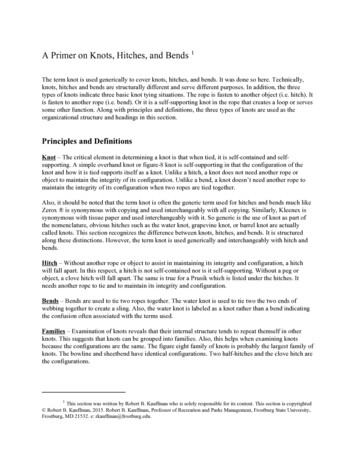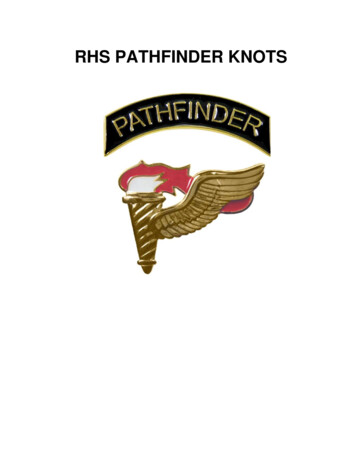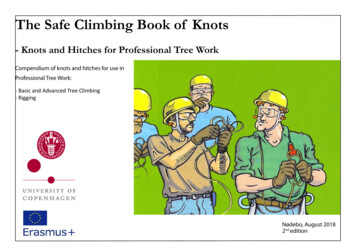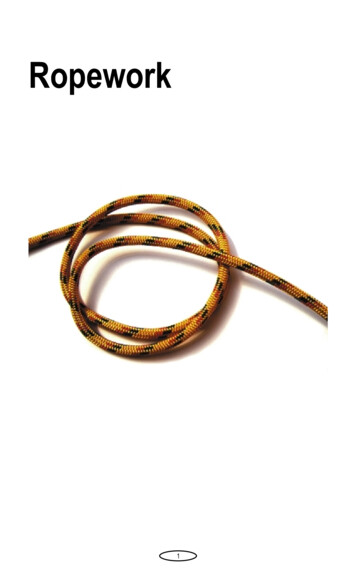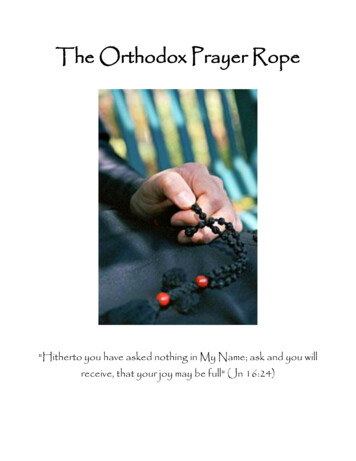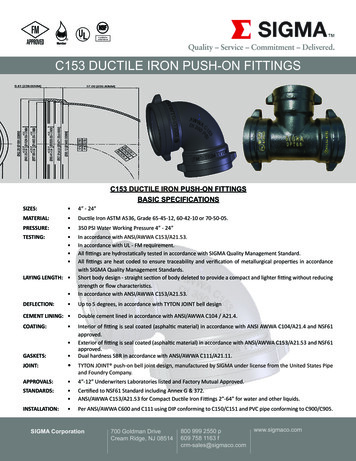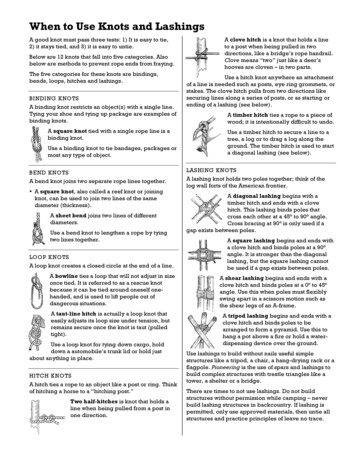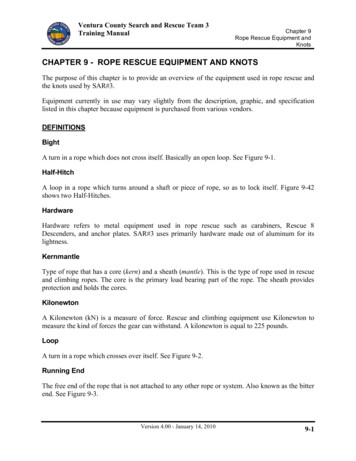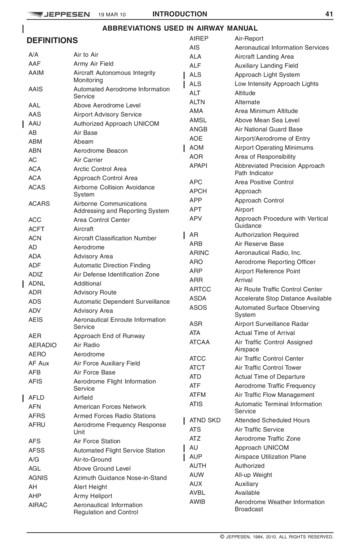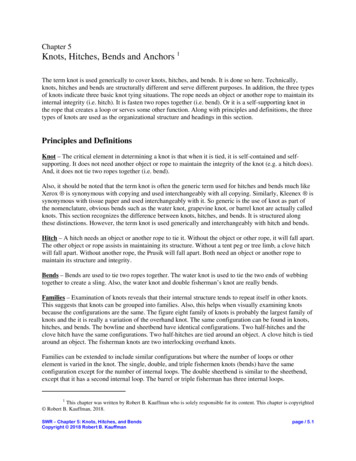
Transcription
Chapter 5Knots, Hitches, Bends and Anchors 1The term knot is used generically to cover knots, hitches, and bends. It is done so here. Technically,knots, hitches and bends are structurally different and serve different purposes. In addition, the three typesof knots indicate three basic knot tying situations. The rope needs an object or another rope to maintain itsinternal integrity (i.e. hitch). It is fasten two ropes together (i.e. bend). Or it is a self-supporting knot inthe rope that creates a loop or serves some other function. Along with principles and definitions, the threetypes of knots are used as the organizational structure and headings in this section.Principles and DefinitionsKnot – The critical element in determining a knot is that when it is tied, it is self-contained and selfsupporting. It does not need another object or rope to maintain the integrity of the knot (e.g. a hitch does).And, it does not tie two ropes together (i.e. bend).Also, it should be noted that the term knot is often the generic term used for hitches and bends much likeXerox is synonymous with copying and used interchangeably with all copying. Similarly, Kleenex issynonymous with tissue paper and used interchangeably with it. So generic is the use of knot as part ofthe nomenclature, obvious bends such as the water knot, grapevine knot, or barrel knot are actually calledknots. This section recognizes the difference between knots, hitches, and bends. It is structured alongthese distinctions. However, the term knot is used generically and interchangeably with hitch and bends.Hitch – A hitch needs an object or another rope to tie it. Without the object or other rope, it will fall apart.The other object or rope assists in maintaining its structure. Without a tent peg or tree limb, a clove hitchwill fall apart. Without another rope, the Prusik will fall apart. Both need an object or another rope tomaintain its structure and integrity.Bends – Bends are used to tie two ropes together. The water knot is used to tie the two ends of webbingtogether to create a sling. Also, the water knot and double fisherman’s knot are really bends.Families – Examination of knots reveals that their internal structure tends to repeat itself in other knots.This suggests that knots can be grouped into families. Also, this helps when visually examining knotsbecause the configurations are the same. The figure eight family of knots is probably the largest family ofknots and the it is really a variation of the overhand knot. The same configuration can be found in knots,hitches, and bends. The bowline and sheetbend have identical configurations. Two half-hitches and theclove hitch have the same configurations. Two half-hitches are tied around an object. A clove hitch is tiedaround an object. The fisherman knots are two interlocking overhand knots.Families can be extended to include similar configurations but where the number of loops or otherelement is varied in the knot. The single, double, and triple fishermen knots (bends) have the sameconfiguration except for the number of internal loops. The double sheetbend is similar to the sheetbend,except that it has a second internal loop. The barrel or triple fisherman has three internal loops.1This chapter was written by Robert B. Kauffman who is solely responsible for its content. This chapter is copyrighted Robert B. Kauffman, 2018.SWR – Chapter 5: Knots, Hitches, and BendsCopyright 2018 Robert B. Kauffmanpage / 5.1
Perhaps the most common knot group is theoverhand knot (Figure 5.1). Add one more halfturn and it becomes the all familiar figure eightknot. Add a third half-turn and the knotbecomes the figure nine knot. So in a very realsense, the figure eight knot is really a variationof the overhand knot. The conclusion is thatthere are a few basic knots with manyvariations.Parts of a Rope (Figure 5.2) – The followingare some commonly used rope terms. It isuseful in orientating and describing the parts ofa rope as well as working with a rope. Some ofthe terminology seemingly overlaps with otherterms, such as the difference between a bightand loop. The purpose of labeling the parts isthat it helps orient the reader when describinghow to tie the knots.Bight – A bight is a bend in the ropewhere the line comes back on itself but doesn’tFigure 5.1 – Overhand Knot Group – Source: Author –cross over itself. It is a loop where the ropedoesn’t cross over itself. It is usually taken out [file:\-KN-OverhandGroup.cdr]of the center of the rope.Loop – In contrast with a bight, a loop is a turn in the rope where the lines cross over each other.When tying a bowline, the first step is to make a loop. The line crosses over each other and held betweenthe thumb and second finger. The first step in tying a trucker’s hitch shown in Figure 5.2 is to create aloop (i.e. actually multiple turns). The second step is to create a bend that is pulled through the loop.Working End – The working end is attached to the item being rigged or hauled. Think of it as theend of the rope working or currently occupied.Standing End – The standing part of a rope includes all the rope excluding the working end.Running End – The running end is the free end of the rope. Sometimes it is called the free end. Itis part of the standing end of the rope and it is the section of the rope used to tie a knot, hitch orsomething else.Tying Considerations – Some knots are selected because of their strength (e.g. figure-8). Some arechosen because a life might depend on the knot being “bombproof” (e.g. figure-8 on a bight). Some knotsare selected because they can be tied quickly and untied easily (e.g. bowline). Others have a specificpurpose or functions (e.g. double fisherman, Prusik, water knot).Function – Many knots are designed for specific uses and functions. A sheetbend and doublefisherman are designed to tie two ropes together. A water knot is designed to tie two pieces of webbingtogether but not two ropes. A bowline is designed to tie a loop in the rope. A clove hitch is designed to tiea rope to a branch or peg.SWR – Chapter 5: Knots, Hitches, and BendsCopyright 2018 Robert B. Kauffmanpage / 5.2
SWR – Chapter 5: Knots, Hitches, and BendsCopyright 2018 Robert B. Kauffmanpage / 5.3
Strength (Figure 5.3) – Tie a knot in a rope and it will immediately lose 1/4 to ½ of its strength.A figure eight retains roughly 75% – 80% of its original strength. In contrast, a square knot retains only43% – 47% of the rope’s original strength (Figure 5.3). The knot creates a stress point where the fibers onthe outside of the bend are stretched more and those on the inside of the bend are stretched less. On theinside of the bend, the strands may even become compressed. The differential in stresses can lead to ropefailure at this point. A good rule to remember is that when the object around which a rope is bent is atleast four times the diameter of the rope (e.g. pulley, branch, a knot, etc), the bend in the rope will beunstressed as a practical matter.Ease to Tie/Untie – A knot should be relatively easy to tie. When tying a line around a post orobject, the bowline is easier and quicker to tie than a figure-8 follow-through.Often overlooked is the ability to easily untie a knot (see Figure 5.12c). A bowline is easy to untie evenafter heavy loading. Just bend the “horse collar” section of the knot over the working end of the rope andthe knot will fall apart. In contrast, once under load, a double fisherman can be virtually impossible tountie. It derives this attribute from its lineage to the overhand knot.Setting and Dressed (Figure 5.4) – In tying a knot, the knot is tied loosely. Setting is the processof tightening the knot so that it becomes dressed. A knot is dressed when it is configured properly. All theparts of the knot are in their proper location and the knot looks as it is pictured in the textbook. This isimportant because, a properly dressed knot makes for easier inspection and an improperly dressed knotcan lose up to 50% of its strength.Inspection (Figure 5.5)– It is important to determine that a knot is tied properly and is safe. Aproperly dressed knot makes it easier to determine if the knot is configured correctly. A figure-8 knot hasa unique and distinct configuration. It looks like the figure eight. In a figure-8 follow-through the secondrope runs parallel to the first rope within the knot. This creates a distinctive pattern. Also, it relates to theknot being properly dressed. Next, there may be a key element of the knot that needs to be checked. In thesquare knot, the two running ends are on the same side of the knot (Figure 5.5). In the “killer square” therunning ends are on opposite sides of the knot. Except for this feature, both knots look identical.Unfortunately, the killer square knot will literally fall apart under tension.Amount of Rope Used – Some knots consume more rope than others. A figure eight on a bight consumes36% more rope than a bowline. Yet both knots create loops in the end of a rope. A simple experiment wasconducted with 8mm cord. With a 2.5" loop, a bowline consumed 11.5 inches of cord. In contrast, afigure eight on a bight consumed 18 inches of cord or 36% more cord than a bowline. This is notinsignificant, and at some point, the amount of rope consumed in tying the knot can affect its use.With its three loops, a triple fisherman’s knot consumes more rope than a double fisherman or a singlefisherman. Leaving a 1" tail, half of a single fisherman consumed 4.25 inches of the 8mm cord. Half ofthe double fisherman consumed 5.75 inches or 26% more cord for the additional loop. With three turns,half of the barrel or triple fisherman consumed 8.25 inches or 30% more cord than the double fisherman.Since not much strength is gained using a triple fisherman over the double fisherman, the doublefisherman can save some rope.Types of a Rope (Figure 5.6) – Several of the common rope types are presented in Figure 5.6. These arelaid, braided and kernmantle. In a laid rope, the strands are usually twisted to be in opposition to eachSWR – Chapter 5: Knots, Hitches, and BendsCopyright 2018 Robert B. Kauffmanpage / 5.4
other. This encourages the rope from becoming unraveled. A major disadvantage of the laid rope is thatabrasion cuts the outside strands which weaken the rope when that strand move inward and becomes asupporting strand.Kenmantle is comprised of the kern and the mantle. The mantle is a woven outer sheathing that protectsthe kern. Kenmantle ropes are either dynamic or static. The kern in a dynamic rope consists of twistedstrands of fibers. Dynamic ropes are used in climbing and are designed to stretch. Specifically, they aredesigned to absorb the fall of a climber. The kern in a static rope consists of parallel unidirectional strandsof fibers. The design minimizes stretch. They are used in rescue situations and not in lead climbing or insituations designed to absorb falls.Ropes are constructed out of nylon, spectra, and polypropylene as well as natural and other materials.Nylon is one of the more common materials. It is strong, flexible, and doesn’t float in water. Spectra ismuch stronger than nylon which is reflected in its cost. Also, it floats. Polypropylene has less strengththan nylon. It is inexpensive and it floats in water. In whitewater situations, spectra is often the rope ofchoice because it is strong and floats.KnotsWhen tied, a knot is self-contained and self-supporting. It doesn’t need an object or another rope tomaintain its integrity (e.g. hitch). This may be a fine distinction, but a distinction non-the-less.Traditionally, the term knot is used to include both hitches and bends. To make matters more confusing,many hitches and bends actually incorporate the term knot in their name. The double fisherman’s knotand water knot are actually bends. Two families of knots are emphasized in this section, the figure eightand bowline.Figure Eight Family (Figure 5.7) – Consider the figure eight knot as the basic knot in this group.Actually, it could be argued that it is really an extension of the overhand knot with one additional turn(see Figure 1). By itself, the figure eight is a stopper knot that is tied at the end of a rope to stop someonewho is repelling from dropping off the line at the bottom of the rope. Other than this, the figure eight byitself has little utility. Other than demonstrating how to tie the knot, this author can’t remember ever usingthe figure eight by itself. Having said this, the figure eight knot is foundational or a base knot for a wholefamily of knots. The figure eight on a bight, figure eight follow through, or in-line figure eight haveutility and considerable usage along with other derivations of the figure eight not noted here.Figure -8 – Figure-eight on a Bight (Figure 5.8) – The figure eight on a bight provides a loop inthe end of the rope. The running end of the rope is made into a bight and the bight is tied as if were asimple figure eight. If the person is creating a loop and then clipping it (i.e. carabiner) into somethingelse, this knot is quick to tie and efficient to use. In contrast, if trying to tie a loop around a person orsome other fixed object, the figure eight on a bight becomes less practical to use.Figure-eight Follow-through (Figure 5.9) – For climbers, this is the knot used to tie into theharness. It is “bullet proof” in that it won’t come undone and it provides maximum protection. It isdesigned to create a loop in the rope connected to the harness or around the person or other object that issecure and provides maximum protection. It is a staple of climbers. The disadvantage of this knot is that itdoes take time to tie. Under normal circumstances this is not a problem. In an emergency situation andwhen time is of the essence, this can become more problematic.SWR – Chapter 5: Knots, Hitches, and BendsCopyright 2018 Robert B. Kauffmanpage / 5.5
SWR – Chapter 5: Knots, Hitches, and BendsCopyright 2018 Robert B. Kauffmanpage / 5.6
In-line Figure Eight (Figure 5.10) – The in-line figure eight is a figure eight tied onto the middleof the main line. It is a specialized knot. It is not difficult to tie and it is relatively easy to untie. It issuperior to tying a overhand knot on a bight which is virtually impossible to untie once loaded. It formsthe base knot in creating a self-equalizing anchor (see next item).Directional Figure Eight Follow-through (Figure 5.11) – The running end of the in-line figureeight is worked back through the loop and then retraced the knot as diagramed. The setup is a selfequalizing anchor system where the pull on each anchor is the same. The system can easily incorporatemultiple anchor points with the addition of another loop. If there is an abundance of carabiners, they canbe used to clip the loops around the anchors to the loop at the bottom of the figure eight.The system has been used in river rescue and to a lesser extent in climbing. The system can be hooked tomultiple D-rings on a raft to extricate it from a pinning. Or it could be used to anchor a haul line tomultiple trees used as anchors where no one tree would serve as a suitable anchor. Actually, it should beSWR – Chapter 5: Knots, Hitches, and BendsCopyright 2018 Robert B. Kauffmanpage / 5.7
used more in climbing since it is truly self-equalizing, particularly when used with carabiners.Bowline (Figure 5.12) – The bowline is used to tie a loop in the end of a rope. The advantage of using thebowline is that it can be tied quickly and easily. Also, it consumes less rope to tie than a figure eightfollow-through. The knot maintains its integrity under tension. However, it can loosen when placed incontinuous tension and compression situations. In the climbing community the bowline has fallen intodisfavor for this reason. When a climber falls, they tend to bounce which can loosen the knot. If there isany doubt that the bowline could be placed in a tension and compression situation, back it up.Untying the Bowline (Figure 5.13) – Even after being placed under extreme tension, the bowline iseasily untied. Bend the working end or “neck” forward. This frees the horse collar which can be flippedover the bent working end (i.e. “neck of the horse”). The knot will easily fall apart.Yosemite Tie-off (Figure 5.14) – If there is a need for a secure bowline, back it off. The Yosemite tie-offis one of several acceptable methods. When tied correctly, the Yosemite tie-off has a figure eight knotlook to it.Other knots can be used to back off the bowline. Half a double fisherman’s knot can be used (not shown).Half a single fisherman can be used in a pinch, but it may need to be tightened periodically since it tendsto be a loose knot (see Figure 5.12d).SWR – Chapter 5: Knots, Hitches, and BendsCopyright 2018 Robert B. Kauffmanpage / 5.8
SWR – Chapter 5: Knots, Hitches, and BendsCopyright 2018 Robert B. Kauffmanpage / 5.9
HitchesA hitch requires an object or another rope to maintain its integrity and structure. Without the object orother rope the hitch will simply fall apart. Several hitches are covered in this section, two half-hitches,clove hitch, Prusik, trucker’s hitch, double fisherman’s, tensionless anchors, and munter hitch.Two Half-hitches (Figure 5.15) – Two half-hitches are commonly used to tie a loop around an object oranother line. It is useful in tying off the running end in a trucker’s knot where it cinches down on the loop(see Figure 5.18). Technically, when tied correctly, the knot has the same configuration as a clove hitch(Figure 5.16a). A common variation is where the loop is looped back against itself (Figure 5.16b). Mostpeople are unaware of the variations and simply tie one or more hitches. This author is unaware of anydifference in strength or holding power between either tying approach. Tying a third or more half-hitch isa common practice and tends to enhance its holding power (Figure 5.16c&d). In addition, tying multiplehalf-hitches is useful for reducing excess rope.Clove Hitch (Figure 5.16) – The clove hitch is used to tie a line to a post or tent peg. The knot has thesame configuration as two half-hitches. The difference is that the clove hitch fastens the running endaround a fixed object (e.g. peg, posts), and two half-hitches fasten the line around another line. The clovehitch is a loose knot and in tension and compression situations, it tends to become loose and undone. Thisauthor usually backs up the clove hitch with two half-hitches to maintain its internal integrity (see Figure5.16c).Prusik (Figure 5.17) – The Prusik is a multi-purpose hitch. It is used in climbing as an ascender and inrescue on hauling systems. In many circles, it is preferred over mechanical devices because it slips ataround 900 lbs of tension. This protects the system from fatiguing elsewhere. The Prusik is a hitchbecause without the main line to maintain its integrity, the knot will fall apart.The Prusik is designed to cinch down on the rope and to kink the rope at an angle to increase its hold. Intheory, the Prusick works best when the diameter of the Prusik is significantly smaller than the main line.In rescue work, this author has used Prusiks with diameters that are close to the main line with littleadverse effect. In swiftwater rescue, most mechanical advantage systems use Prusiks in both the haulingsystem and self-equalizing brake.The first step in making a Prusik is to make a sling. Tie the two ends of the rope together using a doublefisherman’s knot. Next, loop the loop around the main line and through itself as pictured in Figure 5.17.Third is the issue of where the double fisherman knot is located. There are three options. First, the doublefisherman can be positioned over the Prusick as pictured in Figure 5.17. In theory, this minimizes the lossof tensile strength due to a knot in the system and in theory, the tensile strength of the Prusik approachesthat of the rope without a knot. In practice, it may not make that much difference. The Prusik has twosupporting lines. If the rope has a tensile strength of 900 lbs, it has an effective tensile strength of 1,800lbs. It should be noted that some people find it easier to tie the Prusik by positioning the double fishermanover the knot. In addition, some people find it easier to tie the Prusik by latching onto the knot andpassing it through the loops. There is a method to this approach and it works well.The second option is to have the double fisherman located on the side of the sling. As a practical matter,this approach is satisfactory also. Remember, if the Prusik fails (i.e. slips on the rope) at 900 lbs, two1,800 lb tensile strength cords are not going to fail at the knot even if the knot reduces the strength of theSWR – Chapter 5: Knots, Hitches, and BendsCopyright 2018 Robert B. Kauffmanpage / 5.10
Prusik cord by 50%.The third option is to locate the double fisherman where the carabiner fastens into the Prusik. This shouldbe avoided since it places undue stress on the system. Often, when tying the knot, the double fisherman isgrasped and looped through and around the main line. It is convenient. This approach will tend to line upthe knot where the carabiner clips into the sling.For a Prusik to be effective, it needs to be loosened easily and readjusted along the main line. This is athree-step process of loosening the knot, moving it and re-cinching it. It is important to loosen the knotfirst or it will be difficult to move a cinched Prusik. To loosen or untie the Prusik, pull the “horse collar”over itself. Using the first method, this is the double fisherman. Conceptually, this process is similar toloosening the bowline. Prusiks can easily cinch down on the main line making them difficult to move andreadjust.Trucker’s (Rigger’s) Hitch (Figure 5.18) – The trucker’s hitch is used to fasten boats, constructionmaterials, and other items to roof racks on a car, or to fasten lines to tent pegs that are easily adjustable.Close inspection of the rig reveals that the hitch is the same configuration as a Z-rig and offers atheoretical 3:1 mechanical advantage. This mechanical advantage makes the trucker’s hitch an attractiverig for when the line needs to be taught or when the tension on the line needs to be adjusted. Theadjustable lines to the tent pegs are an example of this re-adjustment. The other feature of the trucker’shitch is that it is easy to untie and when untied, the hitch simply falls apart. A key to having it fall aparteasily is to put several twists (i.e. 3-4) in the initial loop.In situations where the tension needs to be monitored or adjusted, or where there needs to be microadjustments made in hauling line, the trucker’s hitch is ideal for these situations. The author uses it as astaple tool to set up and adjust lines in river rescue including the strainer drill.Two half-hitches are used to finish off and lock the trucker’s hitch into place (see Figure 5.15). If there isany doubt regarding the two half-hitches, use three half-hitches. The half-hitches need to be snug againsthe loop or it will slide down the line until it becomes snug. If it is anticipated that the system will bereadjusted, tie the half-hitches using a bight in the rope. Pulling on the one side of the bight unties thehalf-hitches. In addition, extra line can be daisy chained (not shown).Tensionless Anchor (Figure 5.19) – Traditionally, the tensionless anchor has been used to anchor ropesaround trees. This author has used the tensionless anchor to fasten boats, construction items and otheritems to be hauled to the roof racks on his car. It has replaced the trucker’s hitch in this use. It works bythe rope creating friction around the anchor. It is a hitch because it uses the tree or roof rack to maintainits integrity and structure. In contrast, the anchors depicted in the anchor section use slings to create theanchor. At some point there is considerable overlap between a hitch which requires an object for it towrap around and an anchor. In the end, it may be a fine distinction.In Figure 5.19, the tensionless anchor is drawn with the rope neatly coiled around the anchor. This neednot be the case. Only the first two coils should be neatly looped around the anchor and free of crossovers.This aids when finishing off the knot. Feel free to coil the remainder of the rope around the anchor withnumerous crossovers.SWR – Chapter 5: Knots, Hitches, and BendsCopyright 2018 Robert B. Kauffmanpage / 5.11
SWR – Chapter 5: Knots, Hitches, and BendsCopyright 2018 Robert B. Kauffmanpage / 5.12
SWR – Chapter 5: Knots, Hitches, and BendsCopyright 2018 Robert B. Kauffmanpage / 5.13
SWR – Chapter 5: Knots, Hitches, and BendsCopyright 2018 Robert B. Kauffmanpage / 5.14
The literature shows several ways to finish off the tensionless anchor. The first is to let the free end hangloose (not pictured). This is not recommended. If the tensionless anchor is only under tension, the systemwill tend to maintain its integrity and not loosen. Regardless, this author doesn’t like loose ends andprefers a tie off method. However, if the system is under repeated tension and slack, the anchor willloosen and system will begin to fall apart.The second method of finishing off the tensionless anchor is tie a figure eight on a bight and fasten theknot to the main line with a carabiner (not shown). This approach is slightly better than using no tie off. Itdoes provide fail safe protection where if the system loosens and begins to unwind, it will eventually lockdown on itself.The third approach brings the loose free end around the main line on the first coil and cinching it off asshown in Figure 5.19. This is why it is important to neatly coil the first two coils. After the first two coils,the rope can be wrapped in any fashion that is convenient and crossing over itself does not affect theintegrity of the anchor.The author has used this version of the tensionless anchor for years to fasten boats and other items to theroof racks on his car. It replaced the use of the trucker’s hitch for tying down boats on roof racks. It iseasy to tie and untie. It works equally well on metal roof racks. Also, the system tends to maintain itsintegrity when experiencing repeated tension and compression situations. However, if there are knownsituations with extreme repeated tension and compression situations, the author will normally revert to thetrucker’s hitch which will maintain its integrity regardless.Munter Hitch (Figure 5.20) – The munter hitch is a friction device that can be used in place of arappelling device. The author uses it in place of a clove hitch on a carabiner tied off with two half-hitches(not shown). Either way works. The advantage of using either a tied off munter hitch or clove hitch isthat it prevents the carabiner from rotating.BendsBends tie two ropes together. Three bends are covered, the sheetbend, water knot and double fisherman’sknot. A figure eight follow through is not included. However, it can easily be inferred (see Figure 5.9 andFigure 5.11).Sheetbend (Figure 5.21) – The sheetbend is used to tie two ropes together. Careful inspection of the knotreveals that it has the same configuration as a bowline (see also Figure 5.12). Hence, the sheetbend hasmost of the same attributes as a bowline. It tends to be a loose knot. Under tension and slack, it will tendto become loose and come apart. Like the bowline, it is easy to untie. Simply, break the “horse collar” andthe knot falls apart. For additional strength, consider a double sheetbend with two internal loops.Water Knot (Figure 5.22) – The water knot is used to tie two pieces of webbing together to form a sling.This is the primary purpose of the knot and no other knot excels like the water knot in this capacity. It issuch a stable and strong knot, it does not need to be backed up. Normally, it is not used to tie two ropestogether. A sheetbend or figure eight follow through would be preferred.SWR – Chapter 5: Knots, Hitches, and BendsCopyright 2018 Robert B. Kauffmanpage / 5.15
SWR – Chapter 5: Knots, Hitches, and BendsCopyright 2018 Robert B. Kauffmanpage / 5.16
Literally, the knot is tied as a follow-through overhand knot. Tie an overhand knot loosely in thewebbing. With the other end, follow through the knot in reverse. Seat and dress the knot. Avoid kinks.The follow through webbing should parallel the original knot. No backup is needed. The knot maintainsits tightness under stress and compression.Double Fisherman (Figure 5.23) – Normally, the double fisherman is used to fasten two ends of a ropetogether to form a loop or sling. Sometimes, it is called the grapevine knot. It is an integral component increating a sling and tying the Prusik. Half of the knot is often used as a backup knot for other knots. Theknot cinches on itself making it extremely difficult if not virtually impossible to untie after being loaded.For this reason, it is used in situations where it won’t be untied. When tying together two separate linesthat will eventually be untied, other knots such as the sheetbend or figure-8 follow-through would bepreferred.The configuration of the single, double, and triple fisherman are essentially the same except for thenumber of wraps around the rope. The configuration of the single fisherman is that of an overhand knotwith the other end of the rope passing through the center of the other overhand knot. A single fisherman’sknot has one loop. A double fisherman’s knot has two loops and the barrel or triple fisherman’s knot hasthree loops. A single fisherman’s knot tends to be a loose knot and in backup situations, half a doublefisherman is generally preferred. In terms of strength, there is not much difference between a doublefisherman’s knot and the triple fisherman. However, the triple fisherman’s knot consumes more rope. Inmost situations, the double fisherman is more than adequate in
Amount of Rope Used – Some knots consume more rope than others. A figure eight on a bight consumes 36% more rope than a bowline. Yet both knots create loops in the end of a rope. A simple experiment was conducted with 8mm cord. With a 2.5" loo
